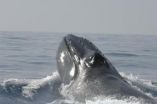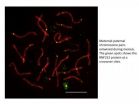(Press-News.org) The reason why some people are worse at learning than others has been revealed by a research team from Berlin, Bochum, and Leipzig, operating within the framework of the Germany-wide network "Bernstein Focus State Dependencies of Learning". They have discovered that the main problem is not that learning processes are inefficient per se, but that the brain insufficiently processes the information to be learned. The scientists trained the subjects' sense of touch to be more sensitive. In subjects who responded well to the training, the EEG revealed characteristic changes in brain activity, more specifically in the alpha waves. These alpha waves show, among other things, how effectively the brain exploits the sensory information needed for learning. "An exciting question now is to what extent the alpha activity can be deliberately influenced with biofeedback", says PD Dr. Hubert Dinse from the Neural Plasticity Lab of the Ruhr-Universität Bochum. "This could have enormous implications for therapy after brain injury or, quite generally, for the understanding of learning processes." The research team from the Ruhr-Universität, the Humboldt Universität zu Berlin, Charité – Universitätsmedizin Berlin and the Max Planck Institute (MPI) for Human Cognitive and Brain Sciences reported their findings in the Journal of Neuroscience.
Learning without attention: passive training of the sense of touch
How well we learn depends on genetic aspects, the individual brain anatomy, and, not least, on attention. "In recent years we have established a procedure with which we trigger learning processes in people that do not require attention", says Hubert Dinse. The researchers were, therefore, able to exclude attention as a factor. They repeatedly stimulated the participants' sense of touch for 30 minutes by electrically stimulating the skin of the hand. Before and after this passive training, they tested the so-called "two-point discrimination threshold", a measure of the sensitivity of touch. For this, they applied gentle pressure to the hand with two needles and determined the smallest distance between the needles at which the patient still perceived them as separate stimuli. On average, the passive training improved the discrimination threshold by twelve percent—but not in all of the 26 participants. Using EEG, the team studied why some people learned better than others.
Imaging the brain state using EEG: the alpha waves are decisive
The cooperation partners from Berlin and Leipzig, PD Dr. Petra Ritter, Dr. Frank Freyer, and Dr. Robert Becker recorded the subjects' spontaneous EEG before and during passive training. They then identified the components of the brain activity related to improvement in the discrimination test. The alpha activity was decisive, i.e., the brain activity was in the frequency range 8 to 12 hertz. The higher the alpha activity before the passive training, the better the people learned. In addition, the more the alpha activity decreased during passive training, the more easily they learned. These effects occurred in the somatosensory cortex, that is, where the sense of touch is located in the brain.
Researchers seek new methods for therapy
"How the alpha rhythm manages to affect learning is something we investigate with computer models", says PD Dr. Petra Ritter, Head of the Working Group "Brain Modes" at the MPI Leipzig and the Berlin Charité. "Only when we understand the complex information processing in the brain, can we intervene specifically in the processes to help disorders", adds Petra Ritter. New therapies are the aim of the cooperation network, which Ritter coordinates, the international "Virtual Brain" project, which her team collaborates on, and the "Neural Plasticity Lab", chaired by Hubert Dinse at the RUB.
Learning is dependent on access to sensory information
A high level of alpha activity counts as a marker of the readiness of the brain to exploit new incoming information. Conversely, a strong decrease of alpha activity during sensory stimulation counts as an indicator that the brain processes stimuli particularly efficiently. The results, therefore, suggest that perception-based learning is highly dependent on how accessible the sensory information is. The alpha activity, as a marker of constantly changing brain states, modulates this accessibility.
###
Funding
The Federal Ministry of Education and Research (Bernstein Focus Learning, "State Dependencies of Learning"), the James S. McDonnel Foundation, the Max-Planck Society (Minerva Programme) and the German Research Foundation (CRC 874, "Integration and Representation of Sensory Processes") funded the project.
Bibliographic record
F. Freyer, R. Becker, H.R. Dinse, P. Ritter (2013): State-dependent perceptual learning, Journal of Neuroscience, doi: 10.1523/JNEUROSCI.4039-12.2013
Figure online
A figure related to this press release can be found online at: http://aktuell.ruhr-uni-bochum.de/pm2013/pm00042.html.en
Further information
PD Dr. Hubert Dinse, Neural Plasticity Lab, Institute for Neural Computation at the Ruhr-Universität, 44780 Bochum, Germany, tel. +49/234/32-25565, e-mail: hubert.dinse@rub.de
PD Dr. Petra Ritter, MPI for Human Cognitive and Brain Sciences, Leipzig; Charité Universitätsmedizin, Berlin, Germany, tel. +49/341/9940-2220, e-mail: petra.ritter@charite.de
Click for more
Neural Plasticity Lab at the RUB
http://www.neuralplasticitylab.de/index.aspx?culture=EN
Previous press release on passive learning without attention
http://aktuell.ruhr-uni-bochum.de/pm2011/pm00136.html.en
Editor: Dr. Julia Weiler
Why there are bad learners: EEG activity predicts learning success
Brain does not process sensory information sufficiently
2013-02-14
ELSE PRESS RELEASES FROM THIS DATE:
Genetic study pursues elusive goal: How many humpbacks existed before whaling?
2013-02-14
Scientists from Stanford University, the Wildlife Conservation Society, the American Museum of Natural History, and other organizations are closing in on the answer to an important conservation question: how many humpback whales once existed in the North Atlantic?
Building on previous genetic analyses to estimate the pre-whaling population of North Atlantic humpback whales, the research team has found that humpbacks used to exist in numbers of more than 100,000 individuals. The new, more accurate estimate is lower than previously calculated but still two to three times ...
Robots with lift
2013-02-14
They can already stand, walk, wriggle under obstacles, and change colors. Now researchers are adding a new skill to the soft robot arsenal: jumping.
Using small explosions produced by a mix of methane and oxygen, researchers at Harvard have designed a soft robot that can leap as much as a foot in the air. That ability to jump could one day prove critical in allowing the robots to avoid obstacles during search and rescue operations. The research is described in a Feb. 6 paper in the international edition of Angewandte Chemie.
"Initially, our soft robot systems used pneumatic ...
Study supports regulation of hospitals
2013-02-14
EAST LANSING, Mich. — Hospital beds tend to get used simply because they're available – not necessarily because they're needed, according to a first-of-its-kind study that supports continued regulation of new hospitals.
Michigan State University researchers examined all 1.1 million admissions at Michigan's 169 acute-care hospitals in 2010 and found a strong correlation between bed availability and use, even when accounting for myriad factors that may lead to hospitalization. These factors include nature of the ailment, health insurance coverage, access to primary care ...
Clues to chromosome crossovers
2013-02-14
Neil Hunter's laboratory in the UC Davis College of Biological Sciences has placed another piece in the puzzle of how sexual reproduction shuffles genes while making sure sperm and eggs get the right number of chromosomes.
The basis of sexual reproduction is that a fertilized egg gets half its chromosomes from each parent — sperm and eggs each contributing one partner in each pair of chromosomes. We humans have 23 pairs of 46 chromosomes: so our sperm or eggs have 23 chromosomes each.
Before we get to the sex part, though, those sperm and eggs have to be formed from ...
Preventing obesity transmission during pregnancy
2013-02-14
A much neglected part of the obesity epidemic is that it has resulted in more overweight/obese women before and during pregnancy. Their offspring also tend to have higher birth weights and more body fat, and carry an increased risk of obesity and chronic diseases later in life. However, the nutritional factors and mechanisms involved pre and during pregnancy that may influence child obesity remain uncertain. A recent publication by ILSI Europe identifies and discusses key contributing factors leading to obesity.
In an article recently published in Annals of Nutrition and ...
Probiotic-derived treatment offers new hope for premature babies
2013-02-14
BETHESDA, Md. (Feb. 13, 2013)—"Good" bacteria that live in our intestines have been linked with a variety of health benefits, from fighting disease to preventing obesity. In a new study, Kriston Ganguli of Massachusetts General Hospital for Children and Harvard Medical School and her colleagues have discovered another advantage to these friendly microscopic tenants: Chemicals secreted by good bacteria that typically live in the intestines of babies could reduce the frequency and severity of a common and often-lethal disease of premature infants.
This disease, known as ...
Marsh plants actively engineer their landscape
2013-02-14
DURHAM, NC -- Marsh plants, far from being passive wallflowers, are "secret gardeners" that actively engineer their landscape to increase their species' odds of survival, says a team of scientists from Duke University and the University of Padova in Italy.
Scientists have long believed that the distribution of plants within a marsh is a passive adaption in which species grow at different elevations because that's where conditions like soil aeration and salinity best meet their needs.
But this team found intertidal marsh plants in Italy's famed Venetian lagoon were ...
Cellular renewal process may underlie benefits of omega fatty acids
2013-02-14
A search for genes that change their levels of expression in response to nutrient deprivation has uncovered potential clues to the mechanism underlying the health benefits of omega fatty acids. In the Feb. 15 issue of Genes & Development, Massachusetts General Hospital (MGH) researchers describe finding that feeding omega-6 fatty acids to C. elegans roundworms or adding them to cultured human cells activates a cellular renewal process called autophagy, which may be deficient in several important diseases of aging. A process by which defective or worn-out cellular components ...
Vanderbilt study reveals clues to childhood respiratory virus
2013-02-14
New Vanderbilt-led research published in the Feb. 14 issue of the New England Journal of Medicine has identified the relatively unknown human metapneumovirus (MPV) as the second most common cause of severe bronchiolitis in young children.
Senior author John Williams , M.D., associate professor of Pediatric Infectious Diseases and a well-known expert in MPV research, said it is gratifying to offer a clearer picture of how this virus impacts children.
"We found MPV is as important a cause of respiratory illness as influenza, and caused more illness than the three common ...
Rewiring the serotonin system
2013-02-14
An interdisciplinary team of researchers from the University of Texas Medical Branch at Galveston and the University of Houston has found a new way to influence the vital serotonin signaling system — possibly leading to more effective medications with fewer side effects.
Scientists have linked malfunctions in serotonin signaling to a wide range of health issues, everything from depression and addictions to epilepsy and obesity and eating disorders. Much of their attention has focused on complex proteins called serotonin receptors, which are located in the cell membrane. ...
LAST 30 PRESS RELEASES:
Interaction of climate change and human activity and its impact on plant diversity in Qinghai-Tibet plateau
From addressing uncertainty to national strategy: an interpretation of Professor Lim Siong Guan’s views
Clinical trials on AI language model use in digestive healthcare
Scientists improve robotic visual–inertial trajectory localization accuracy using cross-modal interaction and selection techniques
Correlation between cancer cachexia and immune-related adverse events in HCC
Human adipose tissue: a new source for functional organoids
Metro lines double as freight highways during off-peak hours, Beijing study shows
Biomedical functions and applications of nanomaterials in tumor diagnosis and treatment: perspectives from ophthalmic oncology
3D imaging unveils how passivation improves perovskite solar cell performance
Enriching framework Al sites in 8-membered rings of Cu-SSZ-39 zeolite to enhance low-temperature ammonia selective catalytic reduction performance
AI-powered RNA drug development: a new frontier in therapeutics
Decoupling the HOR enhancement on PtRu: Dynamically matching interfacial water to reaction coordinates
Sulfur isn’t poisonous when it synergistically acts with phosphine in olefins hydroformylation
URI researchers uncover molecular mechanisms behind speciation in corals
Chitin based carbon aerogel offers a cleaner way to store thermal energy
Tracing hidden sources of nitrate pollution in rapidly changing rural urban landscapes
Viruses on plastic pollution may quietly accelerate the spread of antibiotic resistance
Three UH Rainbow Babies & Children’s faculty elected to prestigious American Pediatric Society
Tunnel resilience models unveiled to aid post-earthquake recovery
Satellite communication systems: the future of 5G/6G connectivity
Space computing power networks: a new frontier for satellite technologies
Experiments advance potential of protein that makes hydrogen sulfide as a therapeutic target for Alzheimer’s disease
Examining private equity’s role in fertility care
Current Molecular Pharmacology achieves a landmark: real-time CiteScore advances to 7.2
Skeletal muscle epigenetic clocks developed using postmortem tissue from an Asian population
Estimating unemployment rates with social media data
Climate policies can backfire by eroding “green” values, study finds
Too much screen time too soon? A*STAR study links infant screen exposure to brain changes and teen anxiety
Global psychiatry mourns Professor Dan Stein, visionary who transformed mental health science across Africa and beyond
KIST develops eco-friendly palladium recovery technology to safeguard resource security
[Press-News.org] Why there are bad learners: EEG activity predicts learning successBrain does not process sensory information sufficiently



